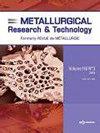Influence of the Mg content on the austenite grain growth in heat-affected zone of offshore engineering steels considering TiN particle pinning and Mo solute drag effects
IF 1.1
4区 材料科学
Q3 METALLURGY & METALLURGICAL ENGINEERING
引用次数: 1
Abstract
The submicrometre and nanometre particle characteristics, soluble element contents, and austenite grain growth behaviors in heat-affected zone of offshore engineering steels with 0.0002 (2Mg) and 0.0042 (42Mg) wt.% Mg during the simulated welding process were studied. With increasing the Mg content in steel from 0.0002 to 0.0042 wt.%, the submicron particles are decreased in number and size with their compositions evolved from TiN to TiN + MgO capped with Mo carbides, and the number density of small-sized nanoparticles increases and large-sized nanoparticles decreases. When the temperature is below 1250 °C, the grain growth rate of two steels is not much different due to the larger Mo solute drag effect in 2Mg and larger pinning force in 42Mg. When the temperature is 1250–1300 °C, the small-sized nanoparticles in 42Mg is more than that in 2Mg, resulting in the larger pinning force and smaller grain growth rate in 42Mg. When heated to 1300–1350 °C and soaked at 1350 °C for 300 s, since large quantities of particles smaller than the critical size (dcr) are dissolved, the grain growth rate in 2Mg is smaller than that in 42Mg due to the greater amount of the effective pinning particles and larger pinning force in 2Mg.考虑TiN颗粒钉扎和Mo溶质阻力效应的Mg含量对海洋工程钢热影响区奥氏体晶粒生长的影响
研究了0.0002 (2Mg)和0.0042 (42Mg) wt.% Mg海洋工程钢在模拟焊接过程中的亚微米和纳米颗粒特征、可溶元素含量及热影响区奥氏体晶粒生长行为。随着钢中Mg含量从0.0002增加到0.0042 wt。%时,亚微米颗粒的数量和尺寸随着组成由TiN向以Mo碳化物为包覆物的TiN + MgO的演变而减少,小尺寸纳米颗粒的数量密度增加,大尺寸纳米颗粒的数量密度减少。当温度低于1250℃时,两种钢的晶粒生长速度差异不大,这是由于2Mg时Mo溶质阻力效应较大,42Mg时钉扎力较大。当温度为1250 ~ 1300℃时,42Mg中的小尺寸纳米颗粒比2Mg中的多,导致42Mg中的钉住力更大,晶粒生长速率更小。当加热到1300 ~ 1350℃,1350℃浸泡300 s时,由于溶解了大量小于临界尺寸(dcr)的颗粒,2Mg中有效钉住颗粒的数量更多,钉住力更大,所以晶粒生长速度比42Mg中要小。
本文章由计算机程序翻译,如有差异,请以英文原文为准。
求助全文
约1分钟内获得全文
求助全文
来源期刊

Metallurgical Research & Technology
METALLURGY & METALLURGICAL ENGINEERING-
CiteScore
1.70
自引率
9.10%
发文量
65
审稿时长
4.4 months
期刊介绍:
Metallurgical Research and Technology (MRT) is a peer-reviewed bi-monthly journal publishing original high-quality research papers in areas ranging from process metallurgy to metal product properties and applications of ferrous and non-ferrous metals and alloys, including light-metals. It covers also the materials involved in the metal processing as ores, refractories and slags.
The journal is listed in the citation index Web of Science and has an Impact Factor.
It is highly concerned by the technological innovation as a support of the metallurgical industry at a time when it has to tackle severe challenges like energy, raw materials, sustainability, environment... Strengthening and enhancing the dialogue between science and industry is at the heart of the scope of MRT. This is why it welcomes manuscripts focusing on industrial practice, as well as basic metallurgical knowledge or review articles.
 求助内容:
求助内容: 应助结果提醒方式:
应助结果提醒方式:


